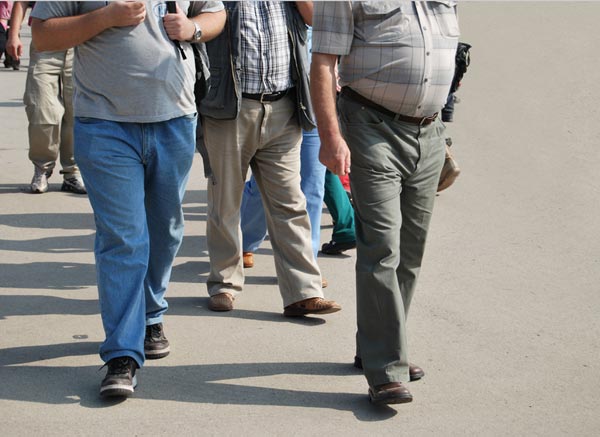How Lab Rats Are Changing Our View of Obesity

Obesity stems primarily from the overconsumption of food paired with insufficient exercise. But this elementary formula cannot explain how quickly the obesity epidemic has spread globally in the past several decades nor why more than one third of adults in the U.S. are now obese. Many researchers believe that a more complex mix of environmental exposures, lifestyle, genetics and the microbiome’s makeup help explain that phenomenon. And a growing body of work suggests that exposure to certain chemicals—found in nature as well as industry—may play an essential role by driving the body to produce and store surplus fat in its tissues. Evidence of that cause-and-effect relationship in humans is still limited, but in laboratory animals and in petri dishes data linking the chemicals to problematic weight gain are mounting. Moreover, the effects in animals appear to be passed on not just to immediate offspring but also grandchildren and great-grandchildren—potentially accounting for some multigenerational obesity. The murkier picture for humans may become clearer in the next five years, says Jerry Heindel, a health science administrator at the National Institute of Environmental Health Sciences. His agency is now funding 57 grants related to obesity and diabetes, he said on March 2 at a meeting of the Institute of Medicine (IOM). The studies look at how chemicals, including those that appear to alter hormone regulation (such as the plasticizer bisphenol A and the antibacterial chemical triclosan), affect weight gain or insulin resistance. Thirty-two of the ongoing studies are in humans. And 20 of those will help assess the longer-term risks to children by tracking the youngsters' chemical levels in utero or as newborns and beyond. None of these studies in people examine multigenerational effects, however, so they will not be able to tell researchers how maternal exposures to such chemicals will influence the health of subsequent generations. Even so, researchers are eyeing it as an important first step. In the next four or five years, Heindel says, the raft of studies will lead to a “huge increase in data.” And gathering such information will be vital in a field where so many bedrock questions remain unanswered: Are there specific periods in their lives when humans may be susceptible to damage? Are there certain populations that may be more vulnerable than others? Would these exposures affect men and women differently? Moreover, how does diet interact with these chemicals or how do the chemicals act collectively? “We live in an ocean of compounds and it’s much more difficult to sort through what’s happening with a mixture of compounds,” Frank Biro, director of adolescent medicine at Cincinnati Children's Hospital Medial Center, said at the IOM meeting, which took place in Research Triangle Park, N.C. Scientists already know that humans are exposed to a potent soup of chemicals even before birth. Some of those chemicals, known as endocrine disruptors, may shut off, turn on or modify signals that hormones produced by the body would otherwise carry. That disruption appears to short-circuit regulation of energy levels and how the body reacts to stress, sometimes with disastrous consequences. Hundreds of contaminants typically found in consumer products, including dozens of flame retardants, numerous pesticides and endocrine disrupting bisphenol A, have been detected in the umbilical cord blood of newborn babies—which means that “to a disturbing extent, babies are born "pre-polluted," according to the President’s Cancer Panel. The presence of these chemicals in the womb, in itself, does not mean they will cause any harm. Animal research, however, suggests that many of these substances may cause serious, long-term consequences. For example, tributyltin, an endocrine disruptor found in water pipes and used in plastics, increases fat mass, reprograms stem cells and produces more fat cells in mice across multiple generations, according to a study published in 2013. Meanwhile, when pregnant rats were exposed to pollutants including common plastics, agricultural chemicals and jet fuel, their great-grandchildren were more likely to be obese or have other disorders, according to research from Washington State University biologist Michael Skinner. As Skinner noted in the August Scientific American, “Some part of the increases in obesity, diabetes and other fast-rising diseases among baby boomers and more recent generations might have originated with their parents’ and grandparents’ exposure to pollutants such as DDT and dioxin.” Some of this trend may be due to alterations that occur in sex cell DNA that are then passed on through affected sperm but more studies need to firm up that relationship. Even as researchers grapple with some of the newer questions about chemical risks for obesity, some experts are still struggling with a longer-standing problem—what to do about the body mass index (BMI). The measurement, which compares height to weight, is typically used as an indicator of obesity (with values over 30 counting as obese). Yet BMI does not account for differences in body composition. For example, two people could have a BMI of 33 but one individual could be a healthy, muscular athlete whereas the other could be obese with related health problems. “People carry fat differently,” says developmental biologist Bruce Blumberg, of the University of California, Irvine, “so maybe it’s not the best metric to use.” One of the most important questions of all, however, is tallying just how many chemicals could be triggering an uptick in fat storage or altering appetite to lead to weight gain and obesity. Blumberg, who first coined the term “obesogens” to describe such powerful chemicals in 2006, says, “I think it’s going to turn out to be many hundreds.”
This article was first published at ScientificAmerican.com. © ScientificAmerican.com. All rights reserved.
Follow Scientific American on Twitter @SciAm and @SciamBlogs. Visit ScientificAmerican.com for the latest in science, health and technology news.
Sign up for the Live Science daily newsletter now
Get the world’s most fascinating discoveries delivered straight to your inbox.










